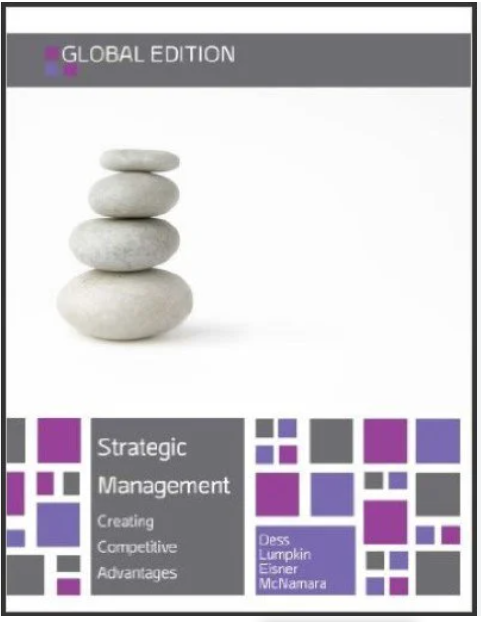Strategic Management Creating Competitive Advantages Global 7th Edition By Gregory Dess – Test Bank
$55.00
Strategic Management Creating Competitive Advantages Global 7th Edition By Gregory Dess – Test Bank
You will receive this product within 24 hours after placing the order
Overview
Chapter 11
Strategic Leadership: Creating a Learning Organization and an Ethical Organization Answer Key
True/false
1. Three key interdependent strategic leadership activities are: designing the organization; determining its direction; and nurturing a culture dedicated to excellence and ethical behavior.
TRUE
Many authors contend that successful leaders must recognize three interdependent activities that must be continually reassessed for organizations to succeed. These are: (1) setting a direction, (2) designing the organization, and (3) nurturing a culture dedicated to excellence and ethical behavior.
2. Setting a direction is the leadership activity that involves developing a strategic vision of what the organization could become.
TRUE
A holistic understanding of the organization stakeholders requires an ability to scan the environment to develop a knowledge of all of the company stakeholders and other salient environmental trends and events. Managers must integrate this knowledge into a vision of what the organization could become.
3. Designing the organization is the leadership activity that involves building structures, teams, systems, and processes that facilitate the implementation of leader vision.
TRUE
When designing the organization, successful leaders are actively involved in building structures, teams, systems, and organizational processes that facilitate the implementation of their vision and strategies.
4. Leaders play an important role in sustaining organization culture, but they are powerless to change it.
FALSE
Leaders play a key role in changing, developing, and sustaining organization culture.
5. Leaders are not expected to accept personal responsibility for ethical behavior in an organization, because ethics is a matter of individual choice.
FALSE
Managers and top executives must accept personal responsibility for developing and strengthening ethical behavior throughout the organization. They must consistently demonstrate that such behavior is central to the vision and mission of the organization.
6. Visionary leadership is only the domain of the CEO, as suggested by the example of Joe Ling at 3M who developed the Pollution Prevention Pays (3P) program.
FALSE
Joe Ling was a vice president of environmental engineering and pollution control at 3M, when he started the Pollution Prevention Pays (3P) program that brought about creative change in the organization. The 3P program not only encourages top executives to rethink products and processes, but also empowers lower-level employees to generate sustainability improvements. The program continues to this day and is an example of visionary leadership that was brought about beyond the domain of the CEO.
7. The tendency of many individuals to throw good money at bad decisions despite negative performance feedback is referred to as escalation.
TRUE
Many people have vested interests in the status quo. People tend to be risk averse and resistant to change. There is a broad stream of research on escalation, wherein certain individuals continue to throw good money at bad decisions despite negative performance feedback.
8. Systemic barriers to change refer to elements of organization design, structure, and reporting relationships that impede the flow of information.
TRUE
Organizations at all levels are prone to inertia and are slow to learn, adapt, and change because there are systemic barriers. The design of organization structure, information processing, reporting relationships, and so forth impede the proper flow and evaluation of information.
9. Behavioral barriers to change occur because of conflicts between departments, conflicts arising from power relationships, and refusal to share information.
FALSE
Behavioral barriers cause managers to look at issues from a biased or limited perspective due to their education, training, work experiences, and so forth. Political barriers refer to conflicts arising from power relationships.
10. According to the Gresham law of planning, operational decisions do not drive out the time necessary for strategic thinking and reflection.
FALSE
According to the Gresham law of planning, operational decisions do drive out the time necessary for strategic thinking and reflection. This tendency is accentuated in organizations experiencing severe price competition or retrenchment, wherein managers and employees are spread rather thin.












Reviews
There are no reviews yet.